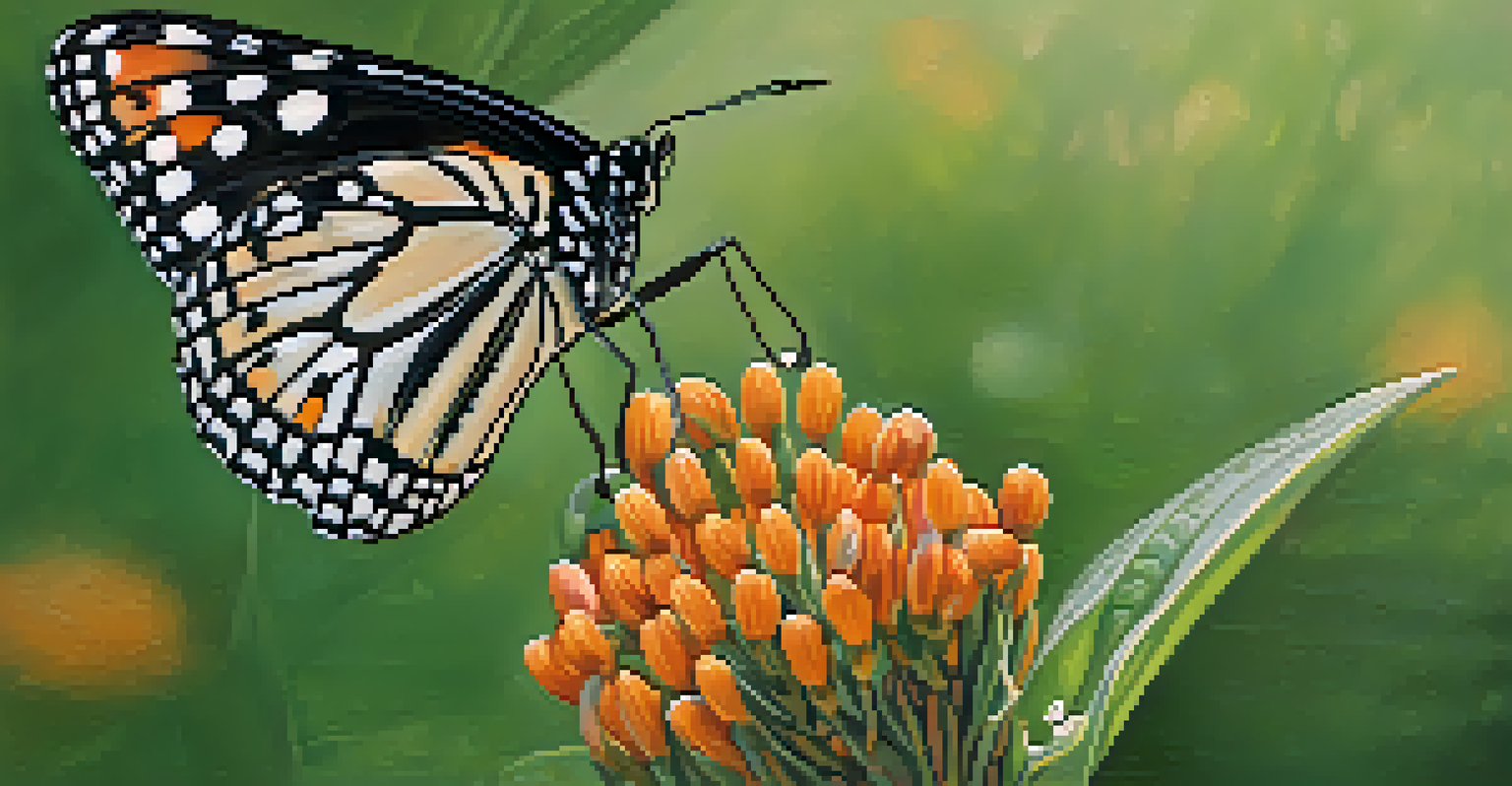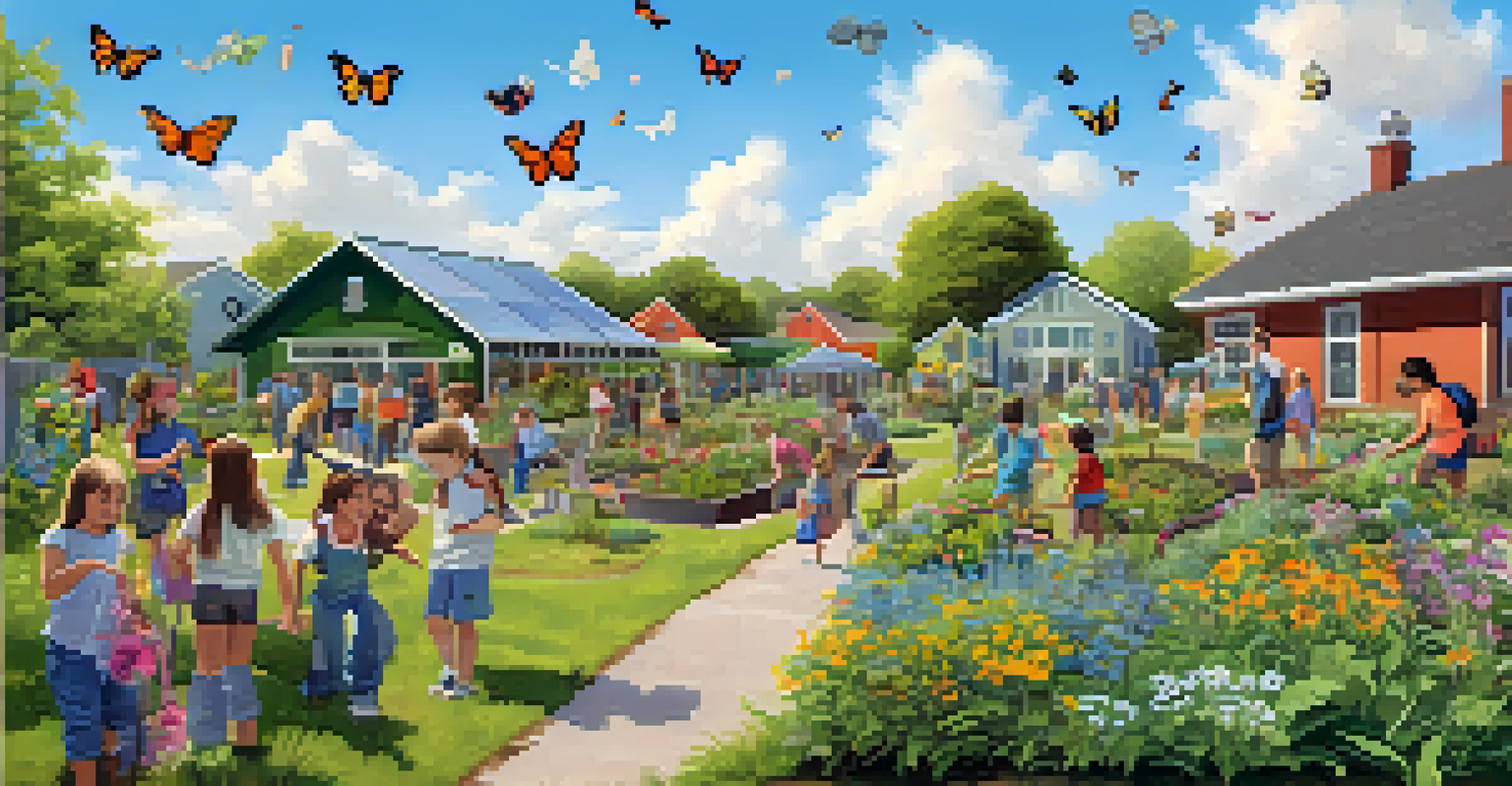How Butterflies Enhance Biodiversity Through Pollination

The Role of Butterflies in Ecosystems
Butterflies are not just beautiful creatures; they play a vital role in ecosystems. As pollinators, they help fertilize plants by transferring pollen from one flower to another. This process is essential for the growth of fruits, seeds, and crops, supporting a wide range of biodiversity.
Butterflies are not just beautiful creatures; they play a vital role in ecosystems.
Without butterflies and other pollinators, many plants would struggle to reproduce, leading to a decrease in plant diversity. This decline can have a cascading effect on the entire ecosystem, impacting animals and humans alike who rely on these plants for food and habitat. Thus, butterflies are crucial for maintaining the health of our environment.
Moreover, healthy butterfly populations signal a thriving ecosystem. Their presence often indicates that the environment is rich with flowering plants, which support not just butterflies, but other pollinators and wildlife as well. This interconnectedness showcases the importance of every species in sustaining biodiversity.
Butterflies as Effective Pollinators
Butterflies possess unique characteristics that make them effective pollinators. Their long proboscis allows them to reach nectar deep within flowers, which many other pollinators cannot access. While feeding, they inadvertently pick up pollen and carry it from flower to flower, facilitating cross-pollination.

Unlike bees, butterflies are less focused on a single flower type, often visiting various plants in one outing. This behavior increases genetic diversity among plants, which is crucial for resilience against pests and diseases. More genetic diversity means stronger plant populations that are better equipped to survive environmental changes.
Butterflies Boost Ecosystem Health
As crucial pollinators, butterflies facilitate plant reproduction, supporting biodiversity and the health of ecosystems.
Additionally, butterflies are attracted to a wide range of flowers, including those that bloom in various seasons. This adaptability helps ensure that pollination occurs throughout the year, benefiting both the plants and the animals that depend on them for food. Thus, butterflies play a pivotal role in the lifecycle of many ecosystems.
Impact of Pollination on Food Production
The pollination services provided by butterflies significantly impact food production. Many of the crops we rely on, such as fruits, vegetables, and nuts, depend on pollinators for a successful harvest. Without adequate pollination, these crops produce fewer yields, which can threaten food security.
The future will be green, or not at all.
In fact, studies have shown that farms with higher butterfly populations often experience increased crop yields. This boost not only benefits farmers financially but also helps stabilize food supplies for communities. The link between butterflies and agriculture highlights the importance of preserving these pollinators.
Furthermore, the decline of butterfly populations due to habitat loss and climate change poses a serious risk to our food systems. Protecting and creating butterfly-friendly environments ensures a sustainable future for both biodiversity and food production. It's a win-win scenario that emphasizes the need for conservation efforts.
Threats to Butterfly Populations
Despite their importance, butterfly populations face numerous threats. Habitat loss due to urbanization, agriculture, and climate change has drastically reduced the spaces where butterflies can thrive. As their natural habitats diminish, so does their ability to pollinate effectively.
Pesticide use is another significant threat to butterflies. These chemicals can harm not only targeted pests but also beneficial insects like butterflies, reducing their populations and subsequently hindering pollination efforts. It’s crucial to find a balance between pest control and protecting essential pollinators.
Pollination Drives Food Production
Butterflies significantly enhance crop yields, making them vital for food security and agricultural success.
Additionally, climate change disrupts the migratory patterns and life cycles of butterflies. Altered temperatures and changing weather patterns can lead to mismatches between the timing of flower blooms and butterfly activity. Addressing these threats is essential to ensure that butterflies can continue their vital role in ecosystems.
Conservation Efforts for Butterflies
Conserving butterfly populations requires a multifaceted approach. Creating butterfly gardens with native plants can provide essential habitats and food sources for these pollinators. By planting a variety of flowers that bloom at different times, we can support butterflies throughout their life cycles.
Engaging in community efforts, such as local conservation programs, can also make a significant impact. These initiatives often focus on educating the public about the importance of butterflies and how to protect them. When communities come together, they can create butterfly-friendly environments that promote biodiversity.
Additionally, supporting sustainable agricultural practices can help protect butterfly habitats. Farmers can adopt methods that minimize pesticide use and promote crop diversity, benefiting both the land and the pollinators. Together, these conservation efforts aim to create a brighter future for butterflies and the ecosystems they support.
The Importance of Native Plants
Native plants play a crucial role in supporting butterfly populations and enhancing biodiversity. These plants are well-adapted to local climates and soil conditions, making them resilient and low-maintenance. They provide essential habitats and food sources for butterflies at various life stages, from caterpillars to adults.
By incorporating native plants into our gardens and landscapes, we not only attract butterflies but also other beneficial insects and wildlife. For example, milkweed is a native plant that supports monarch butterflies during their caterpillar stage. Creating a diverse ecosystem with native plants fosters a thriving environment for all species.
Conservation Efforts are Essential
Protecting butterfly habitats and promoting native plants are key strategies in ensuring their survival and ecosystem balance.
Moreover, native plants require fewer resources like water and fertilizers, promoting sustainability. This approach aligns with conservation efforts by minimizing the environmental impact of gardening and landscaping. Ultimately, choosing native plants is a simple yet effective way to contribute to butterfly conservation and biodiversity.
Engaging Communities in Butterfly Conservation
Community involvement is key to effective butterfly conservation efforts. Local workshops and educational programs can raise awareness about the importance of butterflies and how individuals can make a difference. By informing people about the threats butterflies face, communities can unite to protect these vital creatures.
Creating butterfly habitats in schools, parks, and community gardens is an excellent way to engage people in conservation. These projects can serve as hands-on learning experiences, teaching participants about the life cycle of butterflies and the role they play in pollination. When people see the direct impact of their efforts, they are more likely to continue supporting conservation initiatives.

Furthermore, citizen science projects that involve monitoring butterfly populations can foster a sense of ownership and responsibility. By collecting data on butterfly sightings, community members contribute valuable information to scientists and conservationists. This collaboration enhances our understanding of butterfly populations and supports efforts to protect them.